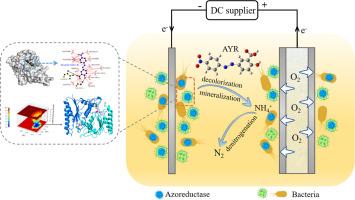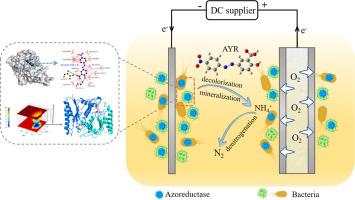在碳限制条件下膜曝气生物电化学系统中染料脱色性能和机制的分子见解
IF 12.4
1区 环境科学与生态学
Q1 ENGINEERING, ENVIRONMENTAL
引用次数: 0
摘要
生物电化学系统(BES)是一种在碳限条件下增强偶氮染料脱色的有前景的方法,但脱色产物需要进一步的好氧矿化。设计了一种反扩散生物膜负载的BES (E-MABR),以实现缺电子废水中茜素黄R (AYR)的脱色、矿化和脱氮。电极的引入促进了细胞外聚合物(EPS)的分泌,尤其是蛋白质(PN),其在阴极生物膜中的含量是MABR的2.5±0.2倍。此外,电刺激富集了电活性细菌(如Geobacter)和偶氮染料代谢因子(如Thauera和Dechloromonas),并显著上调了脱色相关基因的表达,特别是阴极生物膜中的azoR (1.2 log2)。阳极(22.2±1.5%)和阴极(20.1±1.7%)蛋白质结构中β-薄片比例的增加促进了氨基酸中疏水性基团的暴露;因此,形成了更多的氢键,导致分子动力学模拟中更强的疏水相互作用。在电场应力作用下,azoR与AYR的总结合自由能下降到−32.6 kJ·mol⁻¹,增强了配合物的稳定性,为AYR的降解创造了良好的环境。限碳条件下,与MABR相比,E-MABR对AYR的脱色效率、矿化效率和总氮去除率分别提高了32.4±2.3%、29.4±3.6%和18.4±2.0%。本文章由计算机程序翻译,如有差异,请以英文原文为准。


Molecular insights into dye decolorization performance and mechanisms under carbon limited conditions in a membrane aeration-based bioelectrochemical system
Bioelectrochemical systems (BES) is a promising strategy for azo dyes decolorization enhancement in carbon-limited condition, but decolorization products need further aerobic mineralization. Here, a counter-diffusion biofilm-supported BES (E-MABR) was designed to achieve the decolorization, mineralization and denitrogenation of Alizarin Yellow R (AYR) in electron-deficient wastewater. The introduction of electrodes facilitated the secretion of extracellular polymeric substances (EPS), particularly proteins (PN), whose content in the cathodic biofilm was 2.5 ± 0.2 times higher than that in the MABR. Additionally, electrical stimulation enriched electroactivity bacteria (e.g. Geobacter) and azo dyes metabolism contributor (e.g., Thauera and Dechloromonas), and significantly upregulated the expression of decolorization-related genes, particularly azoR (1.2 log2) in the cathodic biofilm. The increased β-sheet proportions of protein structures in the anode (22.2 ± 1.5 %) and cathode (20.1 ± 1.7 %) promoted the exposure of hydrophobic groups in amino acid; consequently, more hydrogen bonds formed, leading to stronger hydrophobic interactions in molecular dynamic simulations. Under the electric field stress, the total binding free energy between azoR and AYR declined to −32.6 kJ·mol⁻¹, enhancing the stability of the complex and creating a favourable environment for AYR degradation. Finally, under carbon-limiting conditions, E-MABR significantly promoted AYR decolorization efficiency, mineralization efficiency, and total nitrogen removal by 32.4 ± 2.3 %, 29.4 ± 3.6 %, and 18.4 ± 2.0 %, respectively, compared to MABR.
求助全文
通过发布文献求助,成功后即可免费获取论文全文。
去求助
来源期刊

Water Research
环境科学-工程:环境
CiteScore
20.80
自引率
9.40%
发文量
1307
审稿时长
38 days
期刊介绍:
Water Research, along with its open access companion journal Water Research X, serves as a platform for publishing original research papers covering various aspects of the science and technology related to the anthropogenic water cycle, water quality, and its management worldwide. The audience targeted by the journal comprises biologists, chemical engineers, chemists, civil engineers, environmental engineers, limnologists, and microbiologists. The scope of the journal include:
•Treatment processes for water and wastewaters (municipal, agricultural, industrial, and on-site treatment), including resource recovery and residuals management;
•Urban hydrology including sewer systems, stormwater management, and green infrastructure;
•Drinking water treatment and distribution;
•Potable and non-potable water reuse;
•Sanitation, public health, and risk assessment;
•Anaerobic digestion, solid and hazardous waste management, including source characterization and the effects and control of leachates and gaseous emissions;
•Contaminants (chemical, microbial, anthropogenic particles such as nanoparticles or microplastics) and related water quality sensing, monitoring, fate, and assessment;
•Anthropogenic impacts on inland, tidal, coastal and urban waters, focusing on surface and ground waters, and point and non-point sources of pollution;
•Environmental restoration, linked to surface water, groundwater and groundwater remediation;
•Analysis of the interfaces between sediments and water, and between water and atmosphere, focusing specifically on anthropogenic impacts;
•Mathematical modelling, systems analysis, machine learning, and beneficial use of big data related to the anthropogenic water cycle;
•Socio-economic, policy, and regulations studies.
 求助内容:
求助内容: 应助结果提醒方式:
应助结果提醒方式:


